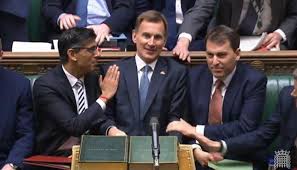When we last saw Jeremy Hunt back in October, delivering his emergency statement, he looked like a recently deposed president being forced to deliver a speech with a military junta holding guns to his head just off screen. He wasn’t quite so miserable delivering the Autumn Statement, with some policies announced to large cheers from his backbenchers, but this was a deeply gloomy affair whose intended audience was international financial markets as much as the House and the British public. His serious tone was to reinforce his October message: that the grown-ups are back in charge, and there are serious problems which need addressing.

The first serious problem, central to Truss and Kwarteng’s view but ominously missing from Hunt’s is growth. The new OBR forecasts, though more optimistic than the Bank of England’s latest, say there isn’t any. The UK is almost certainly already in recession and is likely to remain for at least another year. High inflation means household incomes are likely to fall by 7% over the next two years, a level not seen even during major recessions. That will reduce consumer spending and lower growth further in itself, though the confirmation of inflation-linked increases in benefits is hugely welcome.
The second serious problem is debt, which is increasing rapidly at a time when the cost of servicing debt is also increasing. The chancellor announced £55bn of consolidation, around 2% of GDP, split broadly equally between tax rises and spending cuts. The tax rises will mostly be achieved by every chancellor’s favourite sleight-of-hand, fiscal drag. Keeping personal allowances and tax bands frozen in cash terms out until 2028 means that everyone will pay a little more tax each year as more of their earnings fall outside the personal allowance or lower tax rates. At a time of high inflation, this an easy way to boost revenues without having to increase tax rates, which this government promised it wouldn’t do in its 2019 manifesto.
There were some explicit tax changes on the better off: the 45p additional rate of income tax will now kick-in at around £125,000 from April 2023 rather than £150,000 but raises less than £500m in its first year out of the £7bn of tax increases that begin in the spring. The Dividends allowance and Capital Gains Tax annual exempt amount are to be halved next year, then halved again in 2024, but again the results are small compared to the overall plan. The heavy lifting of getting more tax revenue will mostly be done through those fiscal drag measures that affect all of us.
Though larger businesses will feel the pain through the increase of Corporation Tax from 19% to 25% and through the freezing of the threshold for employers’ National Insurance, smaller businesses with profits below £250,000 will continue to pay at 19%. All businesses will benefit from a freeze in the multipliers for business rates, while retail, hospitality and leisure businesses see their 50% relief which was due to end in March extended for a further year and increased to 75%. Changes to transitional relief arrangements will also support businesses through the revaluation which comes into force in April. While these temporary amendments to business rates are welcome, they further point to a scheme which, through these, is increasingly seen even by government itself as unsustainable in its current form, and is ripe for fundamental review.
Levelling-Up gets a brief mention, with round two of those funds confirmed with at least the previous budget of £1.7bn to be allocated, though it’s worth noting that the effects of high inflation will erode this number, as it is already doing with projects from the first round that are now mid-delivery. It is, like that first round, entirely capital funding, though revenue support for local authorities looks better than expected with an increase in the rate by which councils may raise their rates and more generous grant funding, though again, high rates of inflation, increasing demands on social care and an outdated and regressive Council Tax system which should be reformed alongside business rates all adding to the pressure on revenues and spending.
The longer-term picture, despite some small real terms increase to departmental spending, remains one of high debt, high inflation, weak incomes and constrained investment. Capital investment, frozen in cash terms for the end of this decade and falling rapidly from its current 3% of GDP will further constrain the ability of the UK economy to grow in the future. The chancellor’s hands were at least somewhat tied by the actions of previous, albeit Conservative, administrations, but the lack of any signs of a desire to fundamentally change, or even attempt to change, the trend rate of growth in the economy will continue to make the country poorer than it needs to be over the longer term.
The chancellor and the government have just two years until the next election. They are going to be two of the most challenging years economically that this country has faced for decades. This statement suggests that they will go into the 2024 election on a manifesto of cutting public services. This seems unsustainable, and they will, for all our sakes, need to come back with a more ambitious vision for the UK instead of merely seeking to calm the seas of the financial markets. But they shouldn’t wait for that election: they should begin that path now.